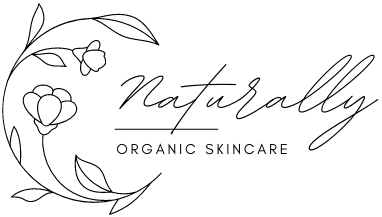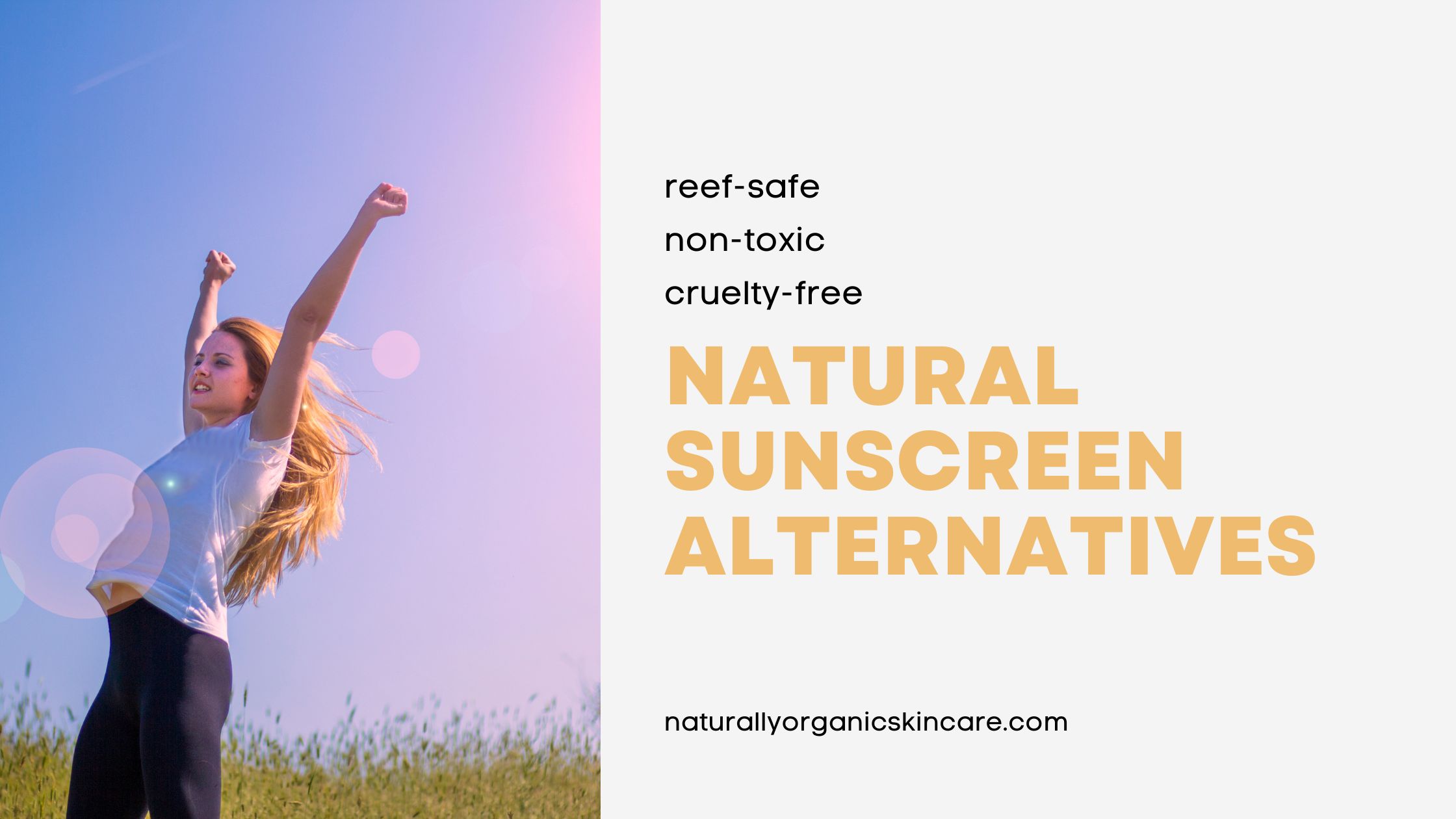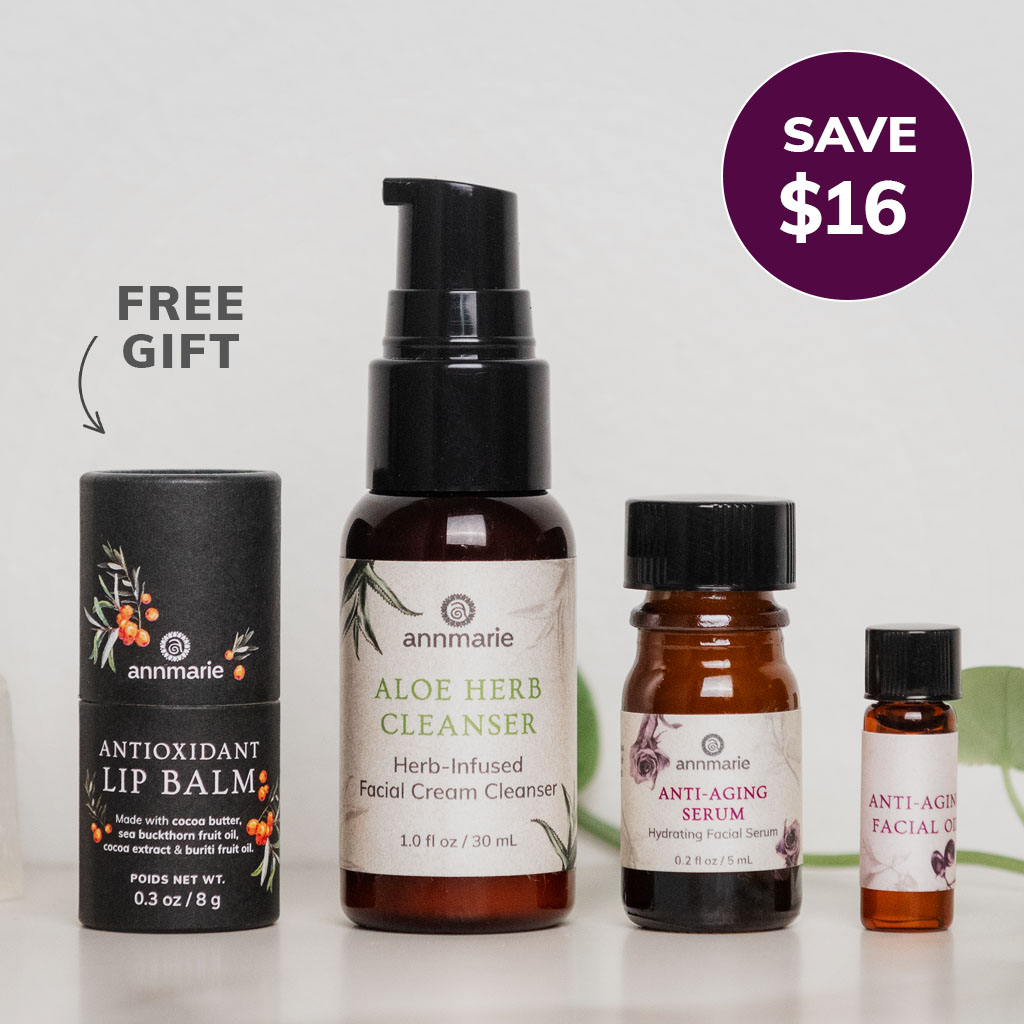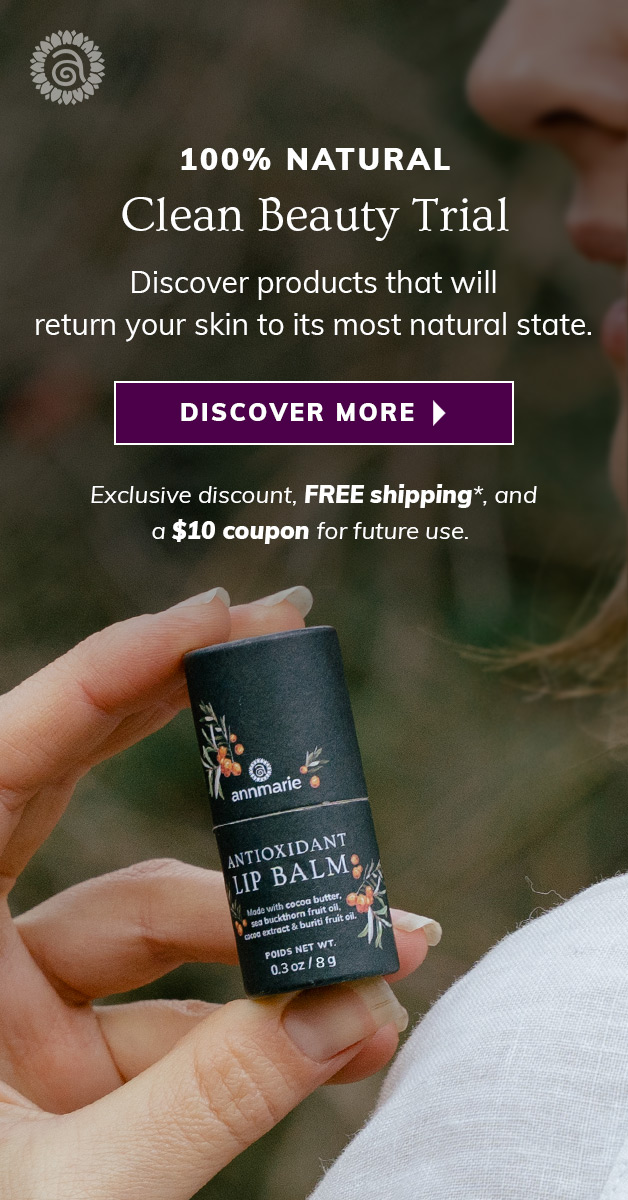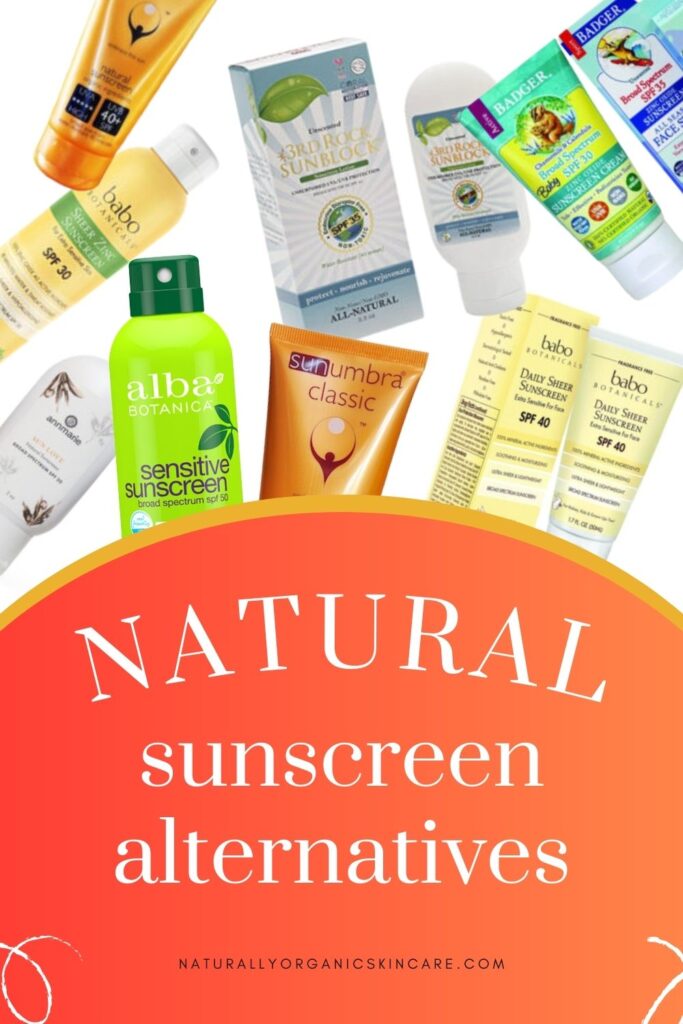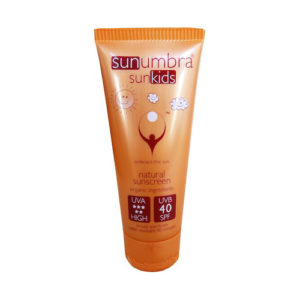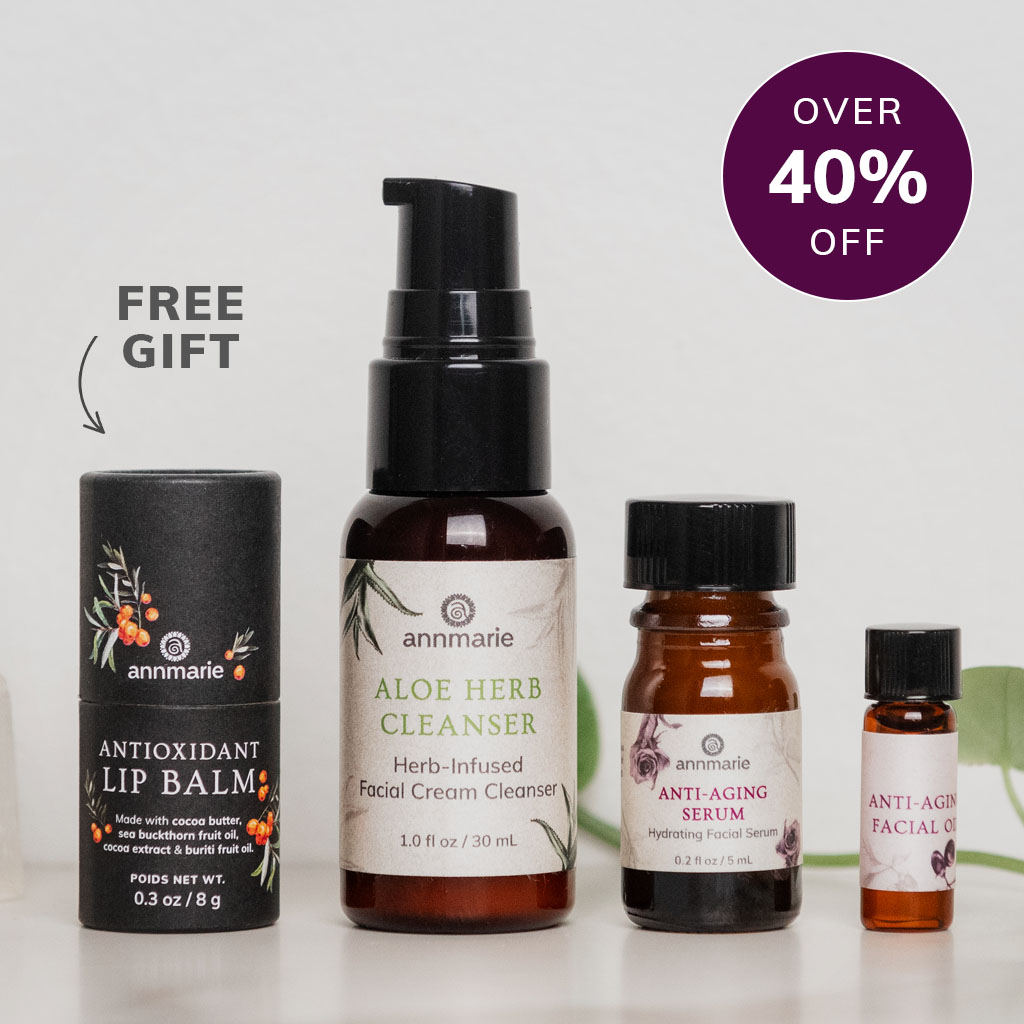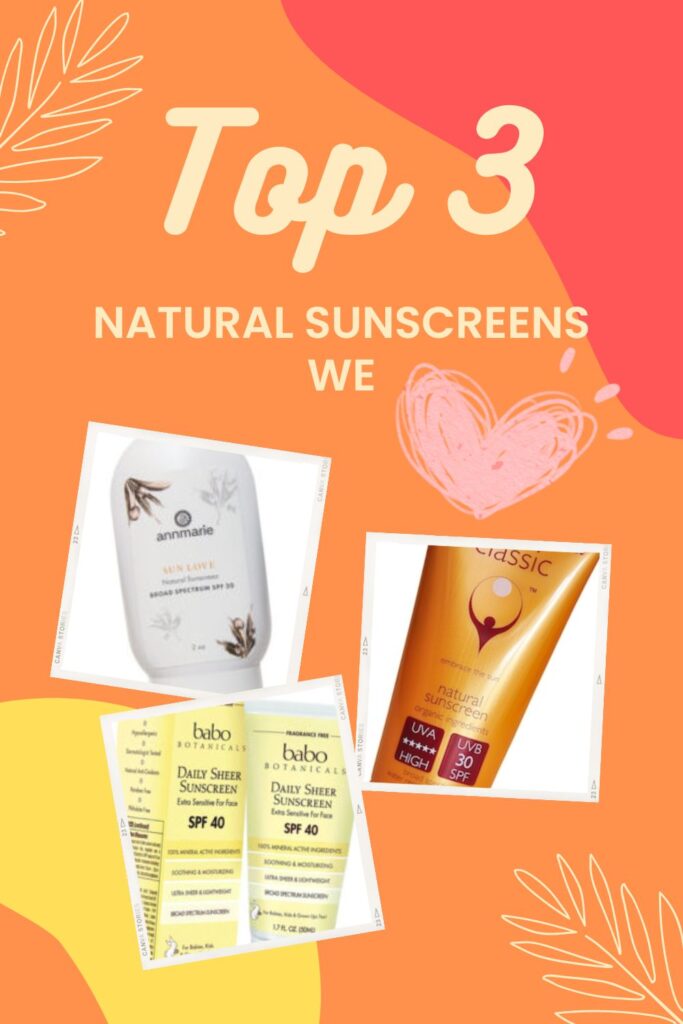A little ladybug on the wall tells me you’re a natural beauty with sunny days ahead! And whether you’re eagerly awaiting the summer season, packing up for the tropics, or getting ready to strap on some skis, your skin needs a helping hand to not look like tomato paste at the end of the day. Well, here are the best natural sunscreen alternatives to prevent that from happening.
Table of Contents
- Which Plant Oils Have Natural SPF?
- Natural Sunscreen Alternatives
- Harmful Ingredients
- Natural Sunscreen Alternatives Are Reef Safe
- Natural Sunscreen Is Cruelty-Free
- These Well-Known Sunscreen Brands: Not Cruelty-Free
- 25 Cruelty-free sunscreen brands
- Best Natural Sunscreens
- Frequently Asked Questions About (Natural) Sunscreen
- Final Thoughts: So Many Choices!
Which Plant Oils Have Natural SPF?
I sincerely hope that when you’re searching for natural sunscreen alternatives, you mean alternative products to conventional sunscreens.
Actual lotions and creams, that are made with natural ingredients.
Because if you are hoping to find a (single) natural substance with the power to protect from the sun? There is no such thing.
There are certain substances that are rumored to offer some protection. Carrot oil, raspberry seed oil, or even coconut oil are sometimes mentioned – heck, some even say you should use straight Aloe Vera gel as sun protection.
Ouch.
Not a good idea.
If your skin is in need of any protection from the sun’s burning rays, please do not resort to those kinds of hippie-dippie shortcuts. (Take that from another hippie-dippie!) Olive oil, sesame oil, jojoba oil, avocado oil, or any other carrier oil – none of these natural oils protect against sun damage.
Essential oils? Nope.
At best, they have a very tiny bit of SPF. Nothing substantial enough to compete with sunscreen lotion. Your skin health is worth some decent protection in the form of an actual effective sunscreen or sunblock.
I can not stress enough that using pure carrot seed oil, red raspberry seed oil, or any other single substance will not do the trick. Ask any dermatologist and they will be able to give you a more detailed (and frightening) response as to why.
Plants oils are wonderful and can have restorative and regenerative properties. Raspberry seed oil and strawberry seed oil are great for skin care, they’re just not sturdy enough for actual protection and no match for a broad-spectrum sunscreen.
So with that established, let’s back into the joy of perusing the best natural alternatives to mainstream commercial sunscreens!
Natural Sunscreen Alternatives
The good news is that, while one single oil or ingredient is not enough, there are fantastic products that combine natural sunscreen ingredients to protect our skin without the use of toxic chemicals.
They combine vegetable oils, extracts, and other soothing ingredients such as shea butter with natural minerals to create a physical barrier on our skin. Most natural sunscreen products rely on minerals to block the sun’s harmful rays. We also call them mineral sunscreens. On the label, you’ll see them mentioned as titanium dioxide, or zinc oxide powder (non-nano zinc oxide) – sometimes both.
These minerals lay on top of the skin, which is why they are referred to as physical sunscreen lotion. They simply reflect the sun’s rays.
Harmful Ingredients
On the other hand, many conventional sunscreens rely on chemical ingredients instead of physical barriers to block harmful UV rays.
How exactly does this work?
I found the best simple, straightforward explanation for all of us non-chemists on piedmont.org.
Chemical sunscreen absorbs into the skin and then absorbs UV rays, converts the rays into heat, and releases them from the body. The active ingredients in chemical sunscreens include avobenzone, octinoxate, and oxybenzone. Physical sunblock sits on top of the skin and reflects the sun’s rays.
That honestly does not sound very healthy, when you think about it. No wonder recently even the world of science and dermatology has started second-guessing chemical sunscreens.
There are rumors that the very ingredients we’ve been encouraged to use to protect against ultraviolet radiation may actually increase the risk of skin cancer. I encourage you to do a quick Google search to find out the latest about this.
At the time of writing, the jury is still out. Doctors are doing the best they can with the information they have.
The fact is that direct sunlight causes skin cancer. Now, traditional sunscreens may indeed neutralize the sun’s UV rays. However, in recent years it has come to light (no pun intended) that the very process through which this takes place might also be a skin cancer risk.
And that, my friend, is why we’re here. You reading this.
Maybe you’re wondering, why take the risk? If there is a natural form of external sun protection, why subject my skin cells to unnecessary damage? I’m with you – and I’ve been using natural (physical) sunscreen for a very long time for that exact reason.
But if the above doesn’t convince you, guess what? There are a few more reasons to use natural sun protection!
How about… Taking a stance against cruel animal testing? Preserving the beautiful coral reef from destruction?
Natural Sunscreen Alternatives Are Reef Safe
We can choose to split from harmful chemicals for the sake of our own bodies, or because we’re concerned about the sensitive skin of our little ones, and those are very valid reasons. But humans do not exist in a vacuum. The measures we take to ward off the harmful effects of the sun impact the environment around us, too.
Did you know that Hawaii has outlawed the use of chemical sunscreens? The most common ingredients in regular sunscreen products are shown to affect the stunning coral reefs people love to explore.
Coral bleaching may have other causes, too. However, sunscreen chemicals are definitely one of them – and one serious enough for an entire state to ban the products containing them.
Natural Sunscreen Is Cruelty-Free
Unless you’ve been living under a rock, you’ll have picked up on the cruelty-free trend in cosmetics. Unfortunately, lab animals are still sometimes used in horrible experiments for the sake of “beauty” – I know, it hardly makes sense that we’re still doing this in 2023, does it?!
Sunscreen plays a big role in animal testing, especially in the United States. Here’s why.
The FDA does not label sunscreen as a cosmetic but as an over-the-counter drug. Drugs are legally required to be tested on animals.
Sunscreen makes up a BIG market share since so many people use it at one moment or another. Imagine the message that would be sent to companies if a lot of people were to make the jump to cruelty-free sunscreen.
Classifying sunscreen as a drug is really just a matter of semantics. In Europe, it falls under cosmetics. Animal testing of cosmetics there has been banned for over ten years ago. There are enough other and better ways in which the safety of products can be determined than through cruel experiments on non-consenting animals. There are countless safe and natural sunscreen alternatives. With so many natural ways to prevent skin damage, animal cruelty should really be a thing of the past.
If kindness to animals is important to you, vote with your wallet. (Thank you for being a compassionate, beautiful soul!)
| For more on cruelty-free cosmetics, check out: Organic Lipstick Brands Top 10: Natural, Cruelty-Free & Vegan Gems Cruelty-Free Mascara: Top Brands Under $30 Cruelty-free Powder Foundation |
Sunscreen that hasn’t been tested on animals is not just the only decent choice for animal lovers, these products are also typically reef-safe. So you’re not only taking a stance against animals in laboratory cages but also helping the less cuddly ones you might meet when snorkeling.
Not to mention how important the overall health of our oceans is in the grand scheme of things. Those natural ingredients in the many cruelty-free sunscreens are what’s best for everyone: the environment, animals, and us humans.
These Well-Known Sunscreen Brands: Not Cruelty-Free
I bet we can all cite at least a good five well-known sunscreen brands off the top of our heads. Sadly, most – if not all – of those test on animals in one way or another.
When you think of how immense the market share of these companies is, there’s definitely some change to be made in the realm of cruelty-free sunscreen and sunblock.
Many of the brands we see on the shelves are nothing other than labels, and part of the portfolio of (=owned by) larger companies. As a rule of thumb, animal lovers should be ready to boycott anything owned by Unilever, Proctor & Gamble, Coty, or Johnson & Johnson.
Some of the better-known sunscreens that aren’t cruelty-free:
- Aveeno
- Banana Boat
- Coppertone
- Dermalogica
- Hawaiian Tropic
- La Roche-Posay
- L’Oreal
- Neutrogena
- Nivea
However, if you think going cruelty-free will limit your options to just a handful of choices you’re about to be pleasantly surprised!
Here’s a long list of cruelty-free sunscreen brands that are also reef-safe (and a lot of them use natural ingredients).
We’ll get into my favorites further down, the so-called “editor’s picks”, as well as favorites for various ages and activities.
Whether you’re ready to charge a long day filled with intense activity (water, sand, buckets of sweat) or are looking to appear fabulous while doing nothing… There’s a perfect natural sunscreen or sun block for it.
25 Cruelty-free sunscreen brands
Not that I’ve spent time actually counting them, but it sure seems like there may be more cruelty-free brands than regular ones!
Some are larger, more established brands of natural(-ish) skincare that have been around for a while. Alba Botanica, Aubrey Organics, Pacifica, and ‘Yes to’ are fairly well-known names that, with a bit of luck, can be found in department stores.
Others are less common “indie” brands you’ll rarely see on shelves, such as 3rdRock, Sunumbra, Annmarie Gianni, or Beauty by Earth. Online is the best way to shop for those. If given a chance, they’re likely to pleasantly surprise you.
Not only is there no shortage of cruelty-free sunscreen brands, but their ranks are also filled with lots of specialty products.
Whether it is for the face, the body, the beach, daily wear under your makeup, or an afternoon in the park – whether you want something with a tint that can almost double as a foundation, something super tenacious for a sweaty hike, or surf session, something gentle enough to protect baby, something affordable enough to slather on the kiddos every day or something exclusive with anti-aging benefits, it’s there.
- Acure
- Alba Botanica
- All Good
- Annmarie Gianni
- Arbonne
- Aubrey Organics
- Babo Botanicals
- Badger
- Beauty by Earth
- Honest Company
- Jason
- John Masters
- Juice Beauty
- Kate Somerville
- Kiss my Face
- Mad Hippie
- MyChelle Dermaceuticals
- Nature’s Gate
- Ocean Potion
- Pacifica
- 100% Pure
- 3rd Rock Essentials
- Suntegrity
- SunUmbra
- Tarte
- Yes to Cucumbers
Does the list seem like a lot to weed through? It is! Not to worry – Next, I’ll go over some personal favorites, and tips for different occasions.
Best Natural Sunscreens
Favorite Sunscreens For The Face
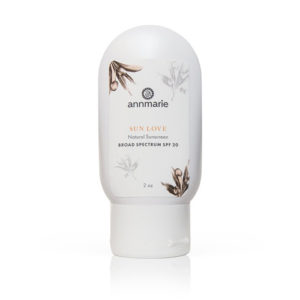
Annmarie Gianni Sun Love is a lovely facial sunscreen for everyday use. It’s “only” SPF 20 but packs a punch. It is completely natural, and many of the ingredients are organic or wild-harvested. This sunscreen has a beige tint, which can be a good or a bad thing depending on your personal preference. It gives my face a really nice, even tone without the need for foundation.
If you’re roughing it with water sports or play, the stuff that requires regular applications, I’d recommend something cheaper. When you want protection to go hand-in-hand with ‘looking the part’, this one’s an excellent choice.

Babo Botanicals Daily Sheer Sunscreen (Extra Sensitive for Face) SPF 40 is another favorite product. It goes on slightly white, but when you’re done spreading it out, the whiteness is totally gone.
I initially got this one for my baby, but I end up grabbing it a lot to protect my own face, too. Babo’s facial sunscreen is not greasy at all. Give it a minute to dry after application, and you’ll see how it totally disappears.
SunUmbra sunscreen also does very well as a facial sunscreen. Anyone of the series would work, but you could try the classic with its beige tint, or the daily for (invisible) medium-high protection.
Speaking of which: protection-wise, SunUmbra is a beast. Coming from someone who gets sunburned on the way to the mailbox, that means a lot! I’ve used it on hikes, outdoor activities, and long walks. It has impressive staying power while being the absolute cleanest sunscreen (free of toxins) you’ll find. The combination of those two crucial things makes SunUmbra a definite winner. The generous tube lasts a very long time, too.
Favorite Sunscreens For The Body
Sunumbra is a cruelty-free sunscreen for the face, the body, or both. It protects really well, isn’t the least intimidated by sweat or water, and is very natural.

Alba Botanica has both products made with chemical and mineral sunscreen ingredients. It is a very popular and, as such, accessible choice.
Unfortunately, I’m not super positive about the Alba sunscreens I’ve tried. Neither are the reviewers of this spray. Alba’s very emollient facial sunscreen, for example, made my eyes tear and sting every single time. Demoted from the face to the body, it worked fine, as long as I didn’t accidentally rub my eyes.
However, I do love them as a brand and would try their other sun products. When you need something right away (any sunscreen trumps no sunscreen!), Alba is a cruelty-free brand you’ll find on the shelves of many stores, from health food stores to supermarkets. Online, find Alba on Amazon, iHerb, and Vitacost at competitive prices.
Best Sunscreen For Babies & Kids

Babo Botanicals is a brand that specifically has babies and small children in mind. It was my baby’s first sunscreen because of its natural and gentle ingredients, sheer/clear coverage, and high SPF. Once more swimming and splashing water are happening, it may be time to switch to something more sturdy but that depends on one’s skin type.
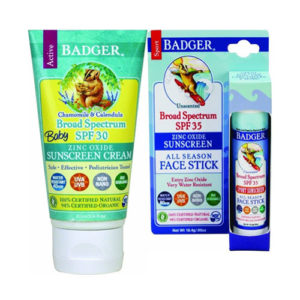
Badger is an accessible, affordable, and very natural choice. The kids may need some convincing the white beach-guard-look is totally hip. 😉 On the flip side, the stick stays in place so well it has to be scrubbed off in the shower at the end of the day.

3rd Rock is available online and is a great natural, organic cruelty-free sunscreen with a hefty amount of 23.5% zinc oxide.
Sunumbra even has a “kids version”, which stays in place better than most other sunscreens. Either one of the Sunumbra series (kids, family, face, regular) shouldn’t disappoint and they can certainly be used interchangeably.
This is the most water resistant sunscreen I’ve found, it is seriously tenacious which is great news for little and big kids who love the outdoors (and their worried caretakers). It will probably take an additional scrub in the tub to wash off properly but the peace of mind is well worth it.
Frequently Asked Questions About (Natural) Sunscreen
What is Sun Protection Factor (SPF), exactly?
SPF stands for Sun Protection Factor.
As for how the sun protection factor is calculated: If you can normally stay in the sun for – let’s say – ten minutes before you start to burn, with an SPF 15 sunscreen on your skin this time gets multiplied by fifteen.
Following this example, you should be able to spend 10 x 15 minutes exposed to sunlight before burning – the number fifteen to be replaced with whichever SPF you’re looking at.
How much sunscreen is ‘enough’?
According to a study done in 2016 on human volunteers, many sunscreens fall short when it comes to living up to the SPF advertised on the bottle. Most of the sunscreen brands tested in this study are not cruelty-free.
La Roche Posay’s Anthelios appeared to be the best-performing one. I have used Anthelios before going cruelty-free and can confirm it works really well.
Out of the ones included in this study, two cruelty-free sunscreens made the ‘recommended’ list: Trader Joe’s Spray SPF 50 and Ocean Potion Protect & Nourish SPF 30.
Another observation from the same study is that mineral sunscreen appears to be less likely to meet their SPF claim than chemical sunscreen. However, they do point out that part of the problem is people don’t use enough and don’t re-apply often enough.
Considering this particular study does not look at the potential cell damage caused by chemical sunscreen, mineral sunscreen is still by far my preferred type. Not all mineral sunscreen lotions have been included either, so any conclusion about sun protection factors falling short can hardly be the bottom line for all physical sunscreens.
It does make pretty clear how important it is to use something with a high SPF, even if you don’t think you need it. Aiming high on the SPF scale (30+) is great for two reasons: to maximize the amount of protection for your skin, and because we just never seem to apply the amount we really should.
How much SPF do you really need?
To match the SPF on the bottle, you need to apply the amount of sunscreen used in the official calculations. Because 2 milligrams per square centimeter of skin sounds rather abstract, we need an easier way to gauge this amount.
When I started looking up the weight of a cream/lotion, I was hoping to find a food-related comparison. (Is 2 mg a grain of rice, a pea-sized dollop, or more like a grape…?)
Something even better popped up. In this article by Nicki Zevola Benvenuti, she calculates how much sunscreen is needed to cover her face. The result: about a quarter teaspoon.
We tend to wear much less sunscreen than the amount that is used to determine the sun protection factor. Between not lathering up with the “proper” amount of lotion, and not reapplying as often as we should, the actual SPF we get from our sunscreen can be much lower.
With that in mind, you would think it sounds logical to choose a cruelty-free sunscreen with the highest SPF you can find. However, when you get into the higher SPF range, here’s another little tidbit worth knowing.
How do SPF values relate to each other?
Picture SPF values as a curve, and imagine that curve shooting up steeply at first, before flattening out. Taking brackets of 20 as an example, the difference in protection between SPF 10 and SPF 30 is much bigger than between SPF 30 and SPF 50.
A product with SPF 50 protects a fair bit more than one with SPF 10. Something with SPF 85 only offers point-something percent more protection than the SPF 50 sunscreen.
Whether that’s a worthwhile investment depends on your skin type. For most people, anything between SPF 30 and 50 is a great choice.
What is the difference between UVA rays and UVB rays?
That one’s easy. Ultraviolet A (UVA) rays have a longer wavelength. They are responsible for premature aging. Ultraviolet B (UVB) rays have a shorter wavelength and are responsible for the skin burning.
Final Thoughts: So Many Choices!
The most effective way to avoid our skin burning and aging prematurely is to wear protective clothing when out and about. And it’s impossible to beat the most simple solution: avoid getting too much sun exposure.
Trying to avoid long periods of sunbathing, and staying out of the sun during peak hours goes a long way. For all the times where this isn’t happening, now you know where to turn for adequate natural protection from the UV radiation and those pesky free radicals.
While any sunscreen is probably still a safer bet than no sunscreen, there are some serious issues with conventional sunscreen products.
Whatever your reason for wanting to switch to a more natural alternative, your skin will thank you – and so will the lab rats and the coral reefs around the world.
Once you go natural, it is seriously hard to back – it’s kind of funny: I now find regular sunscreen lotions to be so crass. They smell like chemicals from a mile away and often irritated my skin and eyes to the point of tears.
As far as natural sunscreens go, we used to have about five options to pick from. Each one of them would leave the skin to look pasty white or, at best, covered with a white film.
Not anymore, though. With the clean beauty market expanding faster than I can type, there are now enough shades, textures, and brands to choose from to make everyone happy! (Including those of you who like the white cast because it makes them look as cool as an Australian beach guard in the eighties.) So let the sun shine!
And feel free to use one of these super-duper-cheerful images to add to your Pinterest boards about safe sunscreen or natural skincare!
